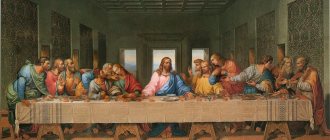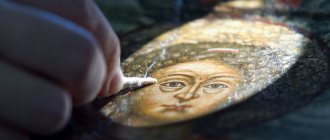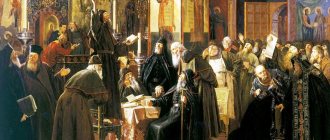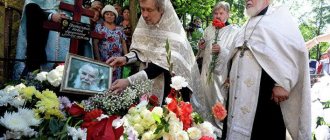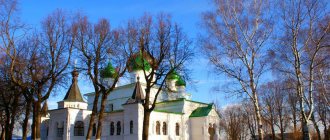What is an iconostasis
The word “iconostasis” came from Greece, where it was formed from two parts: “εἰκών” - image and “στάσις” - standing place. The exact meaning of this word means a partition with images that separates the altar from the middle part of the temple.
Iconostasis - a partition with rows of icons separating the altar from the main part of the temple
Most often it is a large wall reaching to the ceiling, on which icons are located in 3-5 tiers. Occasionally there are low partitions and not solid ones - they allow you to see everything that happens in the altar.
The ranks are arranged from top to bottom and sequentially tell the parishioner the story of God’s creation of man, and the entire history of their relationship. The images and their arrangement differ from temple to temple, but traditionally they are divided into 5 tiers:
- The topmost, fifth tier is the Forefathers.
- The fourth rank is Prophetic.
- The third tier is Festive.
- The second tier is the Deesis.
- The lower rank or first tier is called the Local Row.
Important!
Separating the middle church from the altar, the iconostasis allows us to preserve the sacrament of prayer of the clergy and their preparation for the service. The design of such a partition also has a spiritual meaning - the special arrangement of paintings on it tells the parishioner the story of the creation of man by the Lord. At the top there is always a cross, as a symbol of the culmination of God’s love for man - it was on the cross that Jesus Christ died for all humanity, because God loved this world so much that He sacrificed His Son for it. Occasionally, instead of a crucifix, there may be an icon of the “Crucifixion” on the top of the partition.
History of the development of the iconostasis
Iconostasis (from “icon” and Greek stasis - standing place) is a barrier (partition), which is a solid wall made up of icons, separating the altar from the main room (naos) of an Orthodox church. The Russian type of high iconostasis with rows of icons developed into a con. XIV - beginning XV centuries
The iconostasis is one of the most striking phenomena of Eastern Christian culture. Its formation has a long history. For the first three centuries, persecuted Christians did not have the opportunity to build churches; they held services in their homes or in burial places, for example, in the catacombs. At the same time, the Holy Gifts during the service were in the same room where the worshipers were. In 313, Emperor Constantine the Great granted freedom of religion to all inhabitants of the Roman Empire, after which the massive construction of Christian churches began. The first churches had the form of a basilica (from the word “royal”, “state”, i.e., a building for civil meetings) - an oblong room with a number of columns dividing it into naves. The altar space, symbolizing the Holy Sepulcher, was separated by a low partition. In the Christian East, already in the early Middle Ages, there was a tendency to close the altar, which led to the appearance of the iconostasis. In the early Byzantine temple, the altar barrier was made of marble in the form of four columns on which the architrave rested; the Greeks called it “templon” or “kosmitis”. In Russian, its name began to sound like “tyablo”. Since Russian churches were mainly built of wood, the barriers also became wooden, and the chapel turned into a shelf for icons. The oldest literary source reporting the existence of an altar barrier belongs to Eusebius of Caesarea (c. 260-340). He says that in the temple built in Tire in the 4th century, the altar was separated from the rest of the space by a carved fence. The architrave was usually decorated with carvings depicting vines, peacocks and other symbolic images, and a carved or sculpted cross was placed above the gate. Significantly ancient, according to many researchers, is the use of a woven curtain (katapetasma), which was drawn and pulled back at certain moments of the service. By analogy with the curtain of the Old Testament temple, it separated the “holy of holies” of the church - the altar - the place where the Sacrament was performed. In the letters of the Apostle Paul, the Old Testament veil received a New Testament interpretation and was likened to the flesh of Christ, in connection with which a cross began to be depicted on it, which later became an integral part of the altar barriers.
Separating the altar from the naos, the curtain, barrier, and later the iconostasis served as the boundary between two worlds: the above and below, visible and invisible, and were intended to express their indissoluble connection. The material barrier symbolized the existence of an “immaterial iconostasis,” understood in the Orthodox tradition as a collection of saints, heavenly witnesses, proclaiming to the world what is “beyond the flesh.” Priest Pavel Florensky, and after him many researchers, for example. L. Uspensky, put a lot of effort into proving the spiritual benefits of the iconostasis. In particular, Florensky writes: “The iconostasis is the appearance of saints and angels—hagiophany and angelophany, the appearance of heavenly witnesses, and above all the Mother of God and Christ Himself in the flesh. The iconostasis is the saints themselves. And if all those praying in the temple were sufficiently spiritualized, if the vision of all those praying were always seeing, then there would be no other iconostasis except His witnesses standing before God Himself, with their faces and their words proclaiming His terrible and glorious presence. . The material iconostasis does not hide something from the believers - curious and poignant secrets, ... on the contrary, it points us, half-blind, to the secrets of the altar, opens to us, the lame and crippled, the entrance to another world. But the material iconostasis does not replace the iconostasis of living witnesses and is not placed in their place, but only as an indication of them in order to focus the attention of those praying on them. Direction of attention is a necessary condition for the development of spiritual vision. Figuratively speaking, a temple without a material iconostasis is separated from the altar by a blank wall; The iconostasis breaks through the windows in it, and then through their glass we see, at least we can see, what is happening behind them - living witnesses of God...” One cannot but agree with this, because the semantics of the iconostasis is truly harmonious and consistent, and the main goal of this entire structure is to preach the Kingdom of God.
The historical path of transforming the altar barrier into a high iconostasis is connected precisely with the consistent disclosure of this idea. Already Emperor Justinian (527-565) complicated the shape of the barrier by placing 12 columns in the Church of Hagia Sophia according to the number of apostles, and under Basil the Macedonian (867-886) the image of Christ appeared on the architrave. By the 12th century. a templon in the form of a portico with large icons of the Savior, the Mother of God and the saint of this temple was already widespread. Sometimes a deisis was placed above the royal doors (Christ and the Mother of God and John the Baptist standing before Him in prayer). In some churches already in the 11th century. a series of 12 menain icons (facial calendars) and twelve feasts appears. They were called worshipers: the icon of the holiday was removed from the templon and placed on the lectern for worship, and after the holiday it was returned to its place. In the late Byzantine period, the barrier could reach two or three rows (deisis, apostles and prophets, holidays), but the Greeks still preferred single-tier templons. From Byzantium, the altar barrier came to Rus' and here it was transformed into a multi-tiered iconostasis.
In Russian churches of the pre-Mongol period (XI-XII centuries), the iconostasis usually consisted of a wooden beam - a chapel, on which icons were placed. Sometimes among the icons there was a deisis, written on one board and placed above the Royal Doors. (Two such deisis of the 12th century are on display at the Tretyakov Gallery). Deisis is an image of standing before Christ, the main idea of temple prayer.
Old Russian churches were mostly wooden, it was inconvenient to paint them, and therefore icons began to play a greater role in them than in Byzantium. Icons were grouped by subject and placed on panels. But earlier than the 14th century. nothing is known about the high iconostasis. The first high iconostasis is considered to be the iconostasis of the Annunciation Cathedral of the Moscow Kremlin, consisting of three tiers (in Old Russian - ranks): local, deisis and festive. According to the chronicle, it was created in 1405 by an artel led by Theophan the Greek, Elder Prokhor from Gorodets and monk Andrei Rublev. The beginning of the development of the high iconostasis is associated with the name of the latter: in 1408 he took part in the creation of the iconostasis of the Assumption Cathedral of Vladimir, and in 1425-1427. — Trinity Cathedral of the Trinity-Sergius Lavra.
At the beginning of the 15th century. The iconostasis included three rows, by the end of the century a fourth appeared - prophetic, and at the end of the 16th century. the fifth is the forefathers. And by the 17th century. The type of five-tiered iconostasis is established everywhere, and it is considered to be classic.
But the evolution of the iconostasis does not end there; in the 17th-18th centuries. The rows and height of the iconostasis continue to increase. Six- and seven-tiered iconostases are known (for example, there are seven tiers in the iconostasis of the Great Cathedral of the Donskoy Monastery). The iconostasis began to include passionate rows - the image of the Passion of Christ and the Apostles; Pyadnik row (icons the size of a “span”, i.e. a hand), usually these are icons of the Mother of God or images of saints. A tier of seraphim and cherubim appears above the top row. Sometimes images of Greek sages who predicted the appearance of Christ were included in the iconostasis in an additional rank below the local row (church in Ostankino). Great Moscow Cathedral 1666-1667 decided to complete the iconostasis with the Crucifixion.
But the main evolution of the forms of the iconostasis is associated with the development of decoration. In con. XVII - XVIII centuries The Baroque style, with its lush and intricate decor, comes to Russia from Europe. Belarusian and Ukrainian carvers brought new, more complex woodworking technologies and a new type of carving called “Flemish” (from the German “flaemisch” - Flemish). Dutch and Flemish carvers were known as carving virtuosos; the fashion for it captured all of Europe and came to Russia through Poland and Belarus. “Flemish” iconostases were decorated with rich carvings, covered with abundant gilding, had a bizarre configuration, included high relief and even sculpture. The new aesthetics entailed a change in the design of the iconostasis - from a tyablo (where the icons were installed end to end) it turns into a frame one, essentially becoming a giant carved frame for icons. This, in turn, leads to a change in the design of the temple: the tyablo iconostasis assumed an open altar arch, and for the frame one, a blank wall with small openings for the entrance to the altar is more convenient.
Iconostases of the 18th century. similar to pompous triumphal arches (for example, the iconostasis of the Peter and Paul Cathedral in St. Petersburg, executed in the 1720s according to a drawing by I. Zarudny). Their architectural and sculptural decoration almost replaces the icons, which also become picturesque, the rigor and sequence of orders is not observed, the theological and liturgical meaning of the barrier is ignored. Under Russian influence, carved iconostases also appear in other countries: on Athos, Greece and the Balkans, although they are rarely higher than two or three tiers.
In con. XVIII century Baroque is replaced by classicism, the iconostasis takes on a new image: the stormy dynamics of the “Flemish carving” and the whimsicality of Baroque forms give way to strict columns, porticoes, entablatures, and the decor even more often includes relief and round sculpture. The classic and empire iconostasis becomes architecture within architecture. The role of images is reduced to a minimum. This caused justifiable discontent of the Church; it even went so far as to destroy “non-canonical” iconostases. Thus, by order of Moscow Metropolitan Philaret (Drozdov), the iconostasis by V. Bazhenov was destroyed as not complying with church canons.
From the middle of the 19th century. Iconostases in the “Byzantine-Russian” style come into use. There was little Byzantine, as well as Old Russian, in them; they were eclectic: in design and general appearance they resembled “Flemish” ones, but differed from them in the dryness of forms and other decorative motifs. At the same time, the influence of classicism remained. For example, the iconostasis of the Cathedral of Christ the Savior, made in the form of a tented chapel (canopy): its tent and kokoshniks are made in the “Byzantine-Russian” style, but the independence of this small architectural structure is far from the aesthetics of classicism.
At the turn of the XIX-XX centuries. Art Nouveau comes to Russia - a style also born in Europe, but flexible and skillfully using historical forms. At this time, there is a return to single-tier altar barriers - stone, Byzantine (Kiev Vladimir Cathedral, St. Cyril Church) or wooden, ancient Russian (Pokrovsky Church of the Marfo-Mariinsky Monastery). Original iconostases were also created, for example, from porcelain (Church of St. Pimen on Novoslobodskaya Street) or black bog oak (Church of the Resurrection in Sokolniki).
During the Soviet period, church art was suppressed, but sometimes in one church or another, under the guise of restoring a cultural monument, it was possible to create a new iconostasis. It was difficult to expect new forms at this time; iconostases were created in the aesthetics familiar to the church consciousness of that time, and this was eclecticism. Of the iconostases created during the Soviet period, we note two: in the Tashkent Cathedral, where the icons were painted by M. N. Sokolova (M. Juliana), and in the Church of the Apostle Philip in Novgorod, created through the efforts of Archbishop. Novgorod and Starorussky Sergius (Golubtsov).
1988 was a spiritual milestone for Russia; after the nationwide celebration of the millennium of the Baptism of Rus', the Church finally gained freedom. All over the country they began to restore churches and build new ones, decorate them with icons, and erect iconostases. The gap in tradition, which is felt in more than one generation that grew up without faith, was also reflected in the fact that the enthusiasm of the church people, restoring churches, was sometimes carried out without knowledge of the canons and norms of Orthodox art; there was a lack of artistic taste and understanding of the theological meaning. It is comforting that in our time a whole galaxy of gifted, competent icon painters has appeared, working according to the canons of the high classics of Russian icons of the 14th-15th centuries. Many icon-painting workshops, icon-painting schools and courses appeared. Over the past two decades, thousands of temples have been restored.
St. Daniel's Monastery was one of the first to be restored. Here in the lower church of the Church of the Holy Fathers of the Seven Ecumenical Councils, Archimandrite. Zinon (Theodore) created a three-tier iconostasis, simple, stylized as a tyablo, with an emphasis on iconographic images. With the light hand of the master in many temples, con. 1980s - early 1990s they began to build similar “tyablo” iconostases, decorating them with paintings or modest carvings. But at the same time, there is a clear attraction to tall, multi-tiered forms. Thus, in the upper church of the same temple, the iconostasis was built from five rows.
Along with this, an opposite trend is also visible: a return to earlier and simpler forms - to ancient Russian single-tier iconostases and Byzantine templons. For example, a stone iconostasis with fresco images in the gate church of St. First Martyr Stephen of the Transfiguration of the Savior of the Mirozhsky Monastery in Pskov (archim. Zinon), an altar barrier with mosaic icons in the Church of the Sign in Krasnogorsk, a stone iconostasis of the lower church of the Church of the Assumption in the Assumption Enemy in Moscow.
Today in Russian churches one can see an abundance of a wide variety of stylistic trends: Byzantine, Old Russian, Baroque, from which it is difficult to single out one direction. The current situation is ideal for freedom of creativity: each church can create an iconostasis according to an individual project, based on local characteristics and aesthetic requests of the community.
Origin story
Early Christian history contains no mention of iconostases - initially they simply did not exist, because Christians were forbidden to gather in buildings and were forced to hold services in caves.
Subsequently, when Christianity became an officially permitted religion and the number of parishioners increased, services were moved into buildings, and the place of priest training began to be separated by columns, on which icons were occasionally placed. Only in the 4th century AD. There were references to specially constructed altar barriers in churches.
The iconostasis symbolizes the Kingdom of Heaven
Initially, the barriers were low, making it impossible to completely hide what was happening in the altar. But as the church was decorated with images of saints, they were expanded and made taller. The first appearance of a 4-tier iconostasis dates back to the beginning of the 15th century.
Iconostases developed their development in Ancient Rus' - in Greece, services were held in stone churches, which were decorated abundantly with frescoes, and in the territory of the modern CIS, churches were predominantly wooden, so there was a need for stands for holy images. From the beginning of the 15th century, 4-tier iconostases began to be installed everywhere, but today the 5-tier iconostasis is considered the classic option.
Iconostasis of the Trinity-Sergius Lavra
It is believed that one of the first high iconostases was created at the very beginning of the 15th century for the Assumption Cathedral in Vladimir; it has not survived to this day. But we can see one of the first high iconostases and one of the three iconostases of the 15th century that have come down to us in the Trinity Cathedral of the Trinity-Sergius Lavra. The Trinity Cathedral of the Lavra is the oldest surviving building of the Lavra; it houses one of the greatest shrines of the Russian Orthodox Church - the relics of St. Sergius of Radonezh
Trinity Cathedral of the Trinity-Sergius Lavra
The value of the iconostasis of the Trinity Cathedral of the Trinity-Sergius Lavra is that it is the only complex from the early 15th century that has been preserved in the temple for which it was intended.
Iconostasis of the Trinity Cathedral of the Trinity-Sergius Lavra
This iconostasis was created in 1425-1427.
How the iconostasis works in an Orthodox church
The iconostasis has a strict canonicity - you cannot violate the order of the icons on it, but at the same time, the style of construction does not have strict boundaries, so there are quite a few types of altar barriers.
Bottom row
Here the central place is occupied by the Royal Doors - the doors that lead to the altar (located opposite the Throne) and symbolize the doors to Paradise. On the doors facing the hall there are icons of the Annunciation and the four evangelists. Above the gate is the “Last Supper”, and to the left and right along the edges of the rank are the deacon’s doors through which all the clergy enter the hall.
In the first tier of the iconostasis in the middle there are the Royal Doors
The main image of the bottom row is the image of Christ and the Virgin Mary; they are located to the right and left of the Royal Doors, respectively. After them, local icons are installed - images of saints in whose honor the temple is named or who are especially revered here.
Second row
This rank contains smaller icons than the first, but there are more of them overall. The main theme of the series is the second coming of Jesus Christ to earth, which is why it is called Deesis. The main image of the rite is the image of the Savior on the throne, and in general the collection is subordinated to one theme - a prayer to Christ for mercy.
The Deesis second row symbolizes the Church’s prayer to Christ
On the right and left sides of the main picture are images of John the Baptist and the Virgin Mary “Intercessor”.
Third row
The third tier or Festive collects all the images that depict the twelve feasts - the great events that occurred in the life of Christ and the Virgin Mary. Sometimes it is called Historical, because it tells a brief history of the Gospel, showing people the most significant events: Christmas, Epiphany, Annunciation, etc.
The third row introduces parishioners to the events of the Gospel story
Fourth row
The fourth tier is where the prophets are located, which is why it is called prophetic. Its main goal is to acquaint and introduce people to the history of the Old Testament Church. Therefore, all those people of God who prophesied about the coming and death of Jesus are represented here. In addition to them, the tier contains a painting of the Virgin Mary “The Sign”.
The fourth row depicts the prophets who announced future events
Fifth row
The forefathers' rank in the center contains the image of the Holy Trinity, showing that the Lord is at the head of everything and He was originally there before the creation of the Universe. On both sides of the Holy Trinity there are images of the righteous of the Old Testament: the forefathers Abraham, Isaac and Jacob. There is no clear rule about who exactly should be represented on the icons - this is determined by the one who orders the entire partition.
The top of the iconostasis is crowned with an image of the crucifixion
Construction of the iconostasis
Perhaps we should say something about the structure of the iconostasis. The images on the iconostasis are arranged in rows called tiers or ranks. Each rank has its own name, moving from bottom to top it is: local, deesis, festive, prophetic and forefathers. The tiers of the iconostasis must be read from top to bottom; they illustrate the course of history from ancient times to the present day (in the church interpretation). A five-tiered iconostasis is considered traditional in Orthodoxy, but rows with icons of the Passion of Christ, the Apostolic Passion, and some other compositions can be added. Here, for example, is the Church of the Intercession in Fili, a wonderful example of Naryshkin baroque
Church of the Intercession in Fili
In it, in the lower church, consecrated in honor of the Intercession of the Most Holy Theotokos, there is a three-tier iconostasis. It was created in the 19th century because the decorations on the first floor were looted and desecrated by the French in 1812. The Upper Church of the Savior Not Made by Hands has almost completely retained its original appearance and its main decoration - a stunning eight-tiered iconostasis of an unusual stepped shape.
Upper Church of the Savior Not Made by Hands, Church of the Intercession in Fili
The author of this carved miracle is one of the best masters of the Armory, Karp Ivanovich Zolotarev. The lush floral ornament seems to evoke images of a beautiful Garden of Eden in which the images of saints reside. See how carved decor changes the traditional outlines of icons, gives them unusual oval or multifaceted shapes, and moves them away from a clear division of tiers horizontally
But still, the main evolution of the iconostasis took place in the development of decor. Russian craftsmen were characterized by flat and blind, non-through carving. And the invited Belarusian and Ukrainian carvers worked in the so-called Flemish (i.e. Flemish) manner: incised, voluminous, almost sculptural carving made it possible to decorate interiors with unprecedented pomp and elegance
The left part of the iconostasis of the Church of the Savior Not Made by Hands, Church of the Intercession in Fili
Symbolism
The construction and structure of the iconostasis are regulated by church traditions, but their architecture, style and appearance may vary. However, certain symbolism can still be traced:
- The crucifix is a symbol of the death of Christ, thanks to which a person has eternal life. It is always located at the top of the partition, crowning the entire history of the relationship between man and God.
- Each rank is a certain stage in the history of the Church, starting with the creation of the world and ending with the Kingdom of Heaven.
- The central icon in the tier determines the theme; it is from it that one can understand what rank it is.
- At the center of each rank are the images of Jesus Christ and the Holy Trinity - it is the Lord who is the center of the Universe and human life. Therefore, in any iconostasis there can be seen a clear arrangement of these images, one under the other from top to bottom.
- The theme of the images of the Mother of God on each tier corresponds to the general theme, so on the Deesis it is the “Intercessor”, begging for mercy for sinners, and on the Prophetic it is the “Sign”, confirming all the prophecies about the coming of the Messiah.
At the same time, the style of the iconostasis as a whole, as well as the style of the icons and their content, can differ significantly from temple to temple. Thus, the image of the Last Supper can be replaced by the “Resurrection of Christ”, and the images of the holidays - by paintings from the cycle “The Passion of Christ”.
What are there in modern churches and how are they located?
In modern churches, the structure of the iconostasis, along with other religious aspects, is subject to certain traditions. The formation of the sequence of icons, as well as the number of tiers, in most cases depends on what the characteristic features of the temple architecture are in a particular case.
In sacred buildings with low and flat ceilings, it is advisable to make low iconostases, with one or two tiers. To focus the attention of believers on the beauty and grandeur of the apse paintings, iconostases are installed in the altars, which consist of three tiers. In other situations, classic iconostases are built - that is, five-row ones. In sacred monasteries in Russia and Ukraine there are six- and seven-tiered iconostases. The icons in these two top rows are dedicated to the passions.

